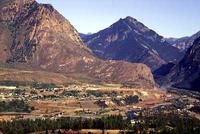Lillooet
LILLOOET () , district municipality, pop 2,324 (2006), occupies the benchlands beside the FRASER R 325 km northeast of VANCOUVER, 65 km north of LYTTON. It was originally known as Cayoosh Flat. The present name comes from the local FIRST NATIONS people, the ST'AT'IMC (Lillooet). To the north, the confluence of the Fraser and BRIDGE rivers at the Six-Mile Rapids was a popular SALMON-fishing site, not only for the St'at'imc but for First Nations from all over the province (see FISHING, ABORIGINAL). The community boomed in the 1860s with the discovery of GOLD on the Fraser and in the CARIBOO. It was the terminus of the DOUGLAS TRAIL from HARRISON LK, used by miners to avoid the steep, narrow canyons of the Fraser. With the building of the CARIBOO WAGON ROAD, Lillooet became Mile 0, but once the GOLD RUSH waned the population declined. The Pacific Great Eastern Rwy (see BC RAIL) arrived in 1912 and during WWII JAPANESE Canadians from the coast were interned here (see JAPANESE, RELOCATION OF). By the late 1990s the largest employer was the FOREST INDUSTRY. Incorporated as a village on 20 Dec 1946, Lillooet is a centre for GINSENG growing and shares with Lytton the distinction of being the hottest spot in Canada: on 29 June 2021 the temperature reached a record 49.6°C at Lytton. With the paving of the Duffey Lake Road from PEMBERTON, the community has become a popular destination with regional travellers.
-
Internet links

